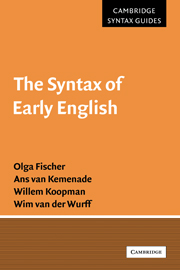Book contents
- Frontmatter
- Contents
- Preface
- List of editions used
- 1 Language change and grammar change
- 2 An outline of Old English syntax
- 3 An outline of Middle English syntax
- 4 The Verb-Second constraint and its loss
- 5 The loss of object–verb word order
- 6 Verb–particles in Old and Middle English
- 7 Changes in infinitival constructions
- 8 The history of the ‘easy-to-please’ construction
- 9 Grammaticalization and grammar change
- References
- Index
7 - Changes in infinitival constructions
Published online by Cambridge University Press: 23 December 2009
- Frontmatter
- Contents
- Preface
- List of editions used
- 1 Language change and grammar change
- 2 An outline of Old English syntax
- 3 An outline of Middle English syntax
- 4 The Verb-Second constraint and its loss
- 5 The loss of object–verb word order
- 6 Verb–particles in Old and Middle English
- 7 Changes in infinitival constructions
- 8 The history of the ‘easy-to-please’ construction
- 9 Grammaticalization and grammar change
- References
- Index
Summary
Introduction
Constructions with infinitival verb forms are a prominent feature of present-day English syntax. The infinitive without to occurs routinely after modal auxiliaries (e.g. I will/might/could do my homework now) and after verbs of perception and causation (e.g. I saw/heard/made him do his homework), while the infinitive with to occurs after a range of verbs with widely varying properties (I tried to do it; I promised Peter to do it; I ordered Peter to do it; I persuaded Peter to do it; I believe him to be innocent). If we compare the distribution and properties of infinitives in the present-day language with their Old English counterparts, the conclusion must be that some pervasive changes have taken place. Some of these changes seem to be largely quantitative: Manabe (1989) has shown, on the basis of a large collection of data, that infinitival clauses replaced finite ones at a fast rate in Middle English. Thus, in Old English (as in present-day German and Dutch), the usual construction after verbs expressing purpose or intention was a poœ-clause, as in (1):
(1) … and bebead am cwellerum æt hi hine mid wium,
and ordered the torturers that they him with cords
handum and fotum on ære rode gebundon
hands and feet on the cross bound
‘and [he] ordered the torturers to fasten his hands and feet with cords to the cross’
(ÆCHom I, 38.594.29)- Type
- Chapter
- Information
- The Syntax of Early English , pp. 211 - 255Publisher: Cambridge University PressPrint publication year: 2001

